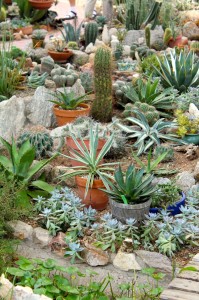
 Extended droughts and excessive heat seem to be becoming the norm in Central Texas and many other parts of the country. This June, more than 170 all-time U.S. heat records were either tied or broken. Cracked earth and wildfires threatened lives and livestock across the nation.
Extended droughts and excessive heat seem to be becoming the norm in Central Texas and many other parts of the country. This June, more than 170 all-time U.S. heat records were either tied or broken. Cracked earth and wildfires threatened lives and livestock across the nation.
The experts don’t all agree on the causes and the debate rages on about greenhouse gasses and global warming.
Whether these recent weather patterns are a natural and temporary period of heating like the dustbowl, or part of a larger, long-term climate change, it’s becoming increasingly difficult to garden around these parts.
So gardeners are doing what gardeners do – trying to second-guess the weather conditions to achieve gardening success.
I recently traveled to Tucson, where I was eager to learn more about their approach in a hotter climate – their gardening techniques and the plants they use. While Tucson is a desert and extremely arid, there are some similarities to our most recent climate changes.
Against the backdrop of the rugged Santa Catalina Mountains, tough, structural plants dot the landscape of the Sonoran Desert.
Cacti, yuccas, hardy woody perennials and trees thrive in the desert. Lawns are a true rarity – even our resort had only a small token strip at the front entrance. The rest of the property was threaded with crushed granite, mulched paths, boulders and native, drought-tolerant plants.
Only the toughest plants survive there, where the temperatures soar into the 100s throughout most of the summer, yet also dip below freezing in winter. They also have a monsoon season, between June and September, when they can get huge amounts of rainfall in very short periods of time.
The soil in the desert is mostly sand or clay or caliche and is alkaline, much like most of Central Texas. Caliche can be just below the soil and retard plant growth. Even worse, caliche can slow drainage to the point that plant roots suffocate and die.
Like Austin and the surrounding area, fall is an excellent planting time in Tucson because the warm soil and moderate temperatures help roots grow to get plants established after the excessive summer heat.
Most of the shrubs and trees we saw throughout the area had very small leaves – a natural survival characteristic which helps reduce plant water loss in heat and drought. Many of the desert plants also have very long taproots, instead of shallow, horizontal surface roots, allowing them to get as much water as possible from deep in the soil. Others have a thick, waxy layer on their leaves to protect them from the heat and sun. And succulents store water in their stems or leaves.
They grow many of our tried and true favorites like lantanas, salvia, agaves, yuccas, acacias, desert willows, daleas, and gopher plants, to name just a few. hey also grow an entire palette of cacti and agaves that we don’t normally find here. Some might provide new interest and structure for our increasingly warmer gardens. We may or may not be able grow some of them here because our climate isn’t as arid, but I’ll be researching more plant varieties as I’m adapting my garden.
With approximately 2,500 different species of cacti, and about 400 different kinds of aloes, there are plenty from which to choose.
My favorite plant towering in the desert was the saguaro cactus, Carnegiea gigantea.
This is one we really can’t grow here — the saguaro only grows in the Sonoran Desert, and it doesn’t do that very fast. Saguaros only grow between 1 to 1-1/2 inches in their first 8 years, according to information published by the Saguaro National Park.
Saguaro can be as old as 75 years old before they grow their first branch. In drier areas, it can take up to 100 years to grow a branch. They begin to bloom at about 35 and can live to be 175 to 200 years old. They can get 50 feet tall and weigh as much as 6 tons.
During a heavy rain, a saguaro absorbs as much water as it can. To accommodate the large amount of water, saguaro’s pleats expand like an accordion. Conversely, when the desert is dry, the saguaro uses its stored water and the pleats contract.
Gardening in a changing climate is a challenge. Our success as gardeners will depend not only on the adaptability of the plants we use, but also on our own adaptability as we consider a different aesthetic in this new climate.

